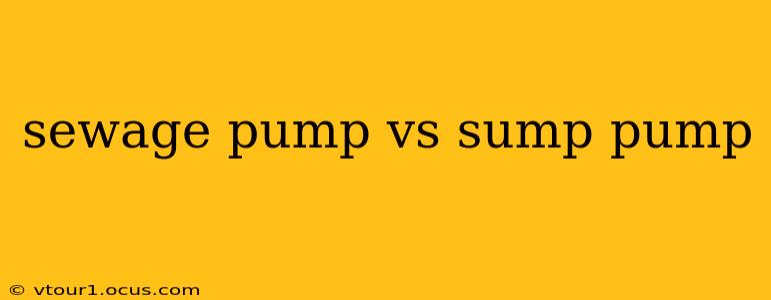Choosing between a sewage pump and a sump pump can be confusing, as both handle wastewater. However, they serve distinct purposes and operate under different conditions. This comprehensive guide will clarify the key differences, helping you select the right pump for your needs.
What is a Sewage Pump?
A sewage pump is designed to handle raw sewage and wastewater containing solids, including human waste, toilet paper, and other debris. These pumps are robust, powerful, and built to withstand harsh conditions. They're typically used in applications where wastewater needs to be moved from a source like a septic tank or sewer line to a higher elevation or a longer distance. Sewage pumps are crucial for effective waste disposal in homes, businesses, and industrial settings.
Key Features of Sewage Pumps:
- High-capacity handling of solids: They're built to handle larger debris than sump pumps.
- Powerful motors: Required to overcome the resistance from thick, solid-laden wastewater.
- Durable construction: Resistant to corrosion and wear from aggressive wastewater components.
- Often submersible: Although some models are non-submersible, many are designed to operate submerged in the wastewater.
- Larger discharge pipes: Designed to accommodate larger solids.
What is a Sump Pump?
A sump pump is primarily used to remove accumulated water from a sump pit – a waterproof pit built into the basement floor. This water usually comes from groundwater seepage, heavy rains, or appliance leaks. Sump pumps are vital for preventing basement flooding and water damage. Unlike sewage pumps, sump pumps typically handle relatively clean water, although some models can handle small amounts of debris.
Key Features of Sump Pump:
- Handles clean or slightly dirty water: Primarily designed for water without significant solids.
- Smaller capacity for solids: Compared to sewage pumps, they are less equipped to handle larger debris.
- Relatively smaller discharge pipes: Suited to the smaller volume of water they handle.
- Often located in a sump pit: Specifically designed to work within a confined space.
- Various types available: Including pedestal sump pumps and submersible sump pumps.
Sewage Pump vs. Sump Pump: Key Differences Summarized
| Feature | Sewage Pump | Sump Pump |
|---|---|---|
| Waste Type | Raw sewage, solids, and other debris | Clean or slightly dirty water |
| Capacity | High capacity for solids | Lower capacity for solids |
| Motor Power | More powerful | Less powerful |
| Construction | Durable, corrosion-resistant | Less robust than sewage pumps |
| Location | Septic tank, sewer line, lift stations | Sump pit in basement or crawlspace |
| Application | Wastewater disposal | Basement flood prevention |
What are the Different Types of Sewage Pumps?
Sewage pumps come in various types, each suited to different applications and needs. These include:
- Submersible sewage pumps: These are completely submerged in the wastewater, ideal for applications where access is limited.
- Non-submersible sewage pumps: These sit above the wastewater level, usually mounted on a platform.
- Grinder pumps: These pumps incorporate a cutting mechanism to shred solids before pumping, allowing for smaller diameter pipes.
What are the Different Types of Sump Pumps?
Sump pumps also offer a variety of options, catering to specific requirements:
- Pedestal sump pumps: The motor sits above the pump, making maintenance and repairs more accessible.
- Submersible sump pumps: The entire pump is submerged, offering quieter operation and preventing overheating.
- Battery backup sump pumps: These pumps have a backup battery system to operate during power outages, vital for preventing flood damage.
How to Choose the Right Pump for Your Needs
The best way to choose between a sewage pump and a sump pump is to carefully consider the type of wastewater you need to handle and the intended application. If you're dealing with raw sewage, a powerful sewage pump is essential. For preventing basement flooding caused by clean water accumulation, a sump pump is the appropriate choice. Consulting a plumbing professional is recommended for larger-scale projects or when unsure of the correct pump type for your specific situation.
What are the maintenance requirements for sewage pumps and sump pumps?
Both sewage and sump pumps require regular maintenance to ensure optimal performance and longevity. This includes regular inspections for leaks, clogs, and wear and tear. It's crucial to follow the manufacturer's recommendations for specific maintenance schedules and procedures. For sewage pumps, particular attention should be paid to the impeller and cutting mechanism (if present) to avoid clogs. For sump pumps, check the float switch to ensure it operates correctly.
How long do sewage and sump pumps last?
The lifespan of both sewage and sump pumps varies depending on the frequency of use, maintenance, and the quality of the pump. With proper maintenance, a high-quality pump can last for many years, often a decade or more. However, harsh operating conditions or infrequent maintenance can significantly shorten their lifespan.
This detailed comparison will hopefully help you make an informed decision when choosing between a sewage pump and a sump pump. Remember to prioritize safety and consult a qualified professional if you need assistance.
